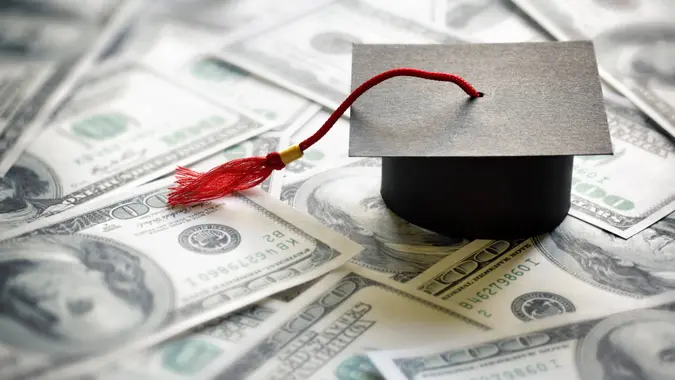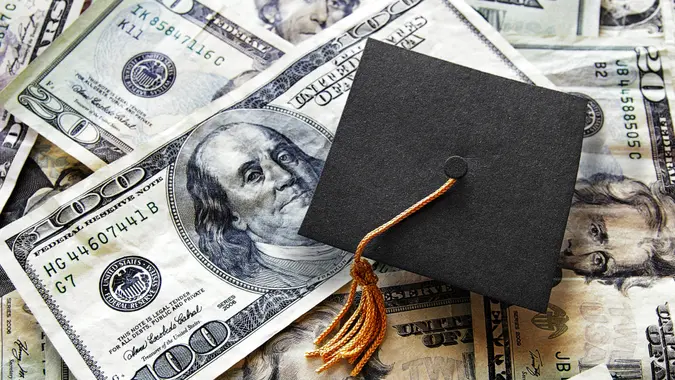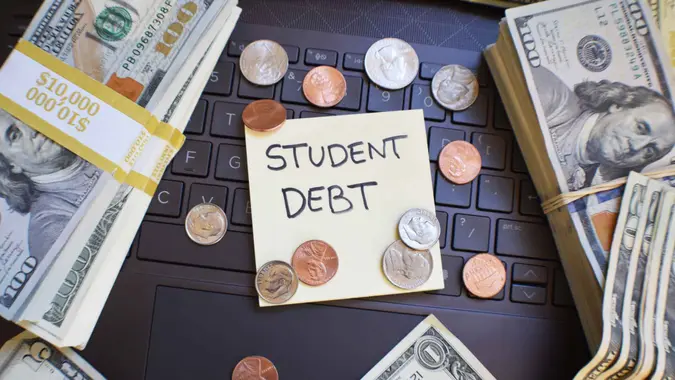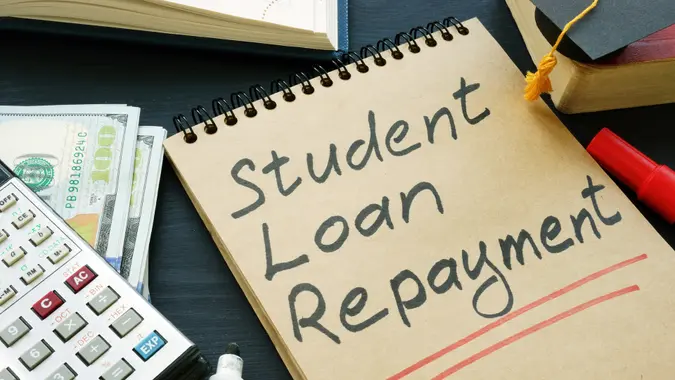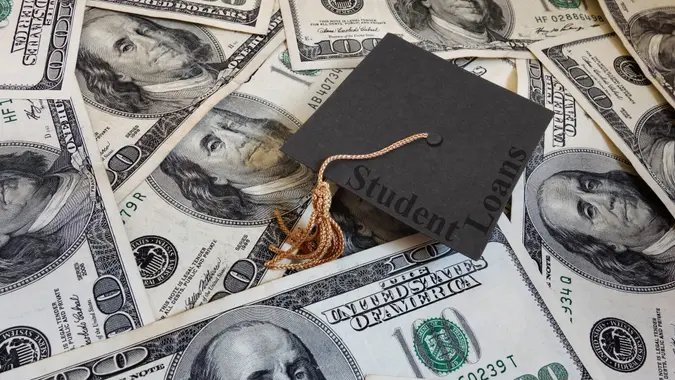Federal vs. Private Student Loans: Key Differences and Which To Choose

Commitment to Our Readers
GOBankingRates' editorial team is committed to bringing you unbiased reviews and information. We use data-driven methodologies to evaluate financial products and services - our reviews and ratings are not influenced by advertisers. You can read more about our editorial guidelines and our products and services review methodology.

20 Years
Helping You Live Richer

Reviewed
by Experts

Trusted by
Millions of Readers
Student loans make it easier for people to attend college amid rising tuition costs. These loans have lengthy terms that minimize the monthly payments, but you still have to compare loans to decide which one is right for you. As you compare student loans, you will come across two types: federal student loans vs. private student loans. This guide will cover how these types of student loans differ and how to compare lenders.
What Are Federal Student Loans?
The government provides federal student loans to those who may need funding to attend college or university. Federal student aid programs issue these loans, which are funded by taxpayers. There are several types of these available.
Direct Subsidized Loans
The direct subsidized loan is offered to undergraduate students who are in financial need. The Department of Education will make interest payments on the loan while you are in school. Your interest will continue to be subsidized during grace periods and deferment periods. You will need to start repaying this loan six months after you graduate or if you drop below half-time enrollment.
Direct Unsubsidized Loans
These loans are just like direct subsidized loans, but they have one key difference. You are responsible for making interest payments the moment you receive the loan. Interest will accumulate while you are in school. Technically, you only have to start repaying it six months after you graduate or drop below half-time enrollment. However, you should start paying it while you are in school, since interest accumulation can make the debt more difficult to cover in the future.
PLUS Loans
PLUS loans allow parents to borrow money so they can pay for their children’s education. Borrowers may be eligible for the Public Service Loan Forgiveness program if they work at a qualifying nonprofit organization or government agency while making 120 qualifying payments.
Federal Consolidation Loans
These financial products let borrowers consolidate their federal education loans into a new loan. That way, they can reduce their monthly payment and preserve their access to federal forgiveness programs. You cannot combine multiple private student loans into a federal consolidation loan. You also can’t mix federal and private student loans in this type of debt consolidation. It only applies to federal student loans.
What Are Private Student Loans?
Private student loans can be issued by banks, credit unions and online lenders. These loans aren’t eligible for federal forgiveness programs, but some people flock to them for lower interest rates. Some people may also have to take out private student loans since federal loans have limits on how much you can borrow each year. Private student loans offer more flexibility than federal loans, but federal loans offer more protection.
Federal vs. Private Student Loans: Key Differences
Federal and private student loans can get you through college, but there are a few key differences. Here’s what you should know.
Interest Rates and Fees
Federal loans typically have fixed interest rates, while you can get a fixed rate or a variable rate with a private student loan. Furthermore, federal law assigns a fixed interest rate for all borrowers. It’s based on the 10-year Treasury note rate plus a small bump.
However, private student lenders can look at more variables, like your credit score and debt-to-income ratio, when deciding what interest rate to give you. Private student loans can end up with much higher APRs than federal loans if you don’t have a good credit score. Both loans may come with fees, such as origination or late fees.
Eligibility and Credit Requirements
Federal student loans don’t require a credit check, which makes them perfect for students who might have a short or limited credit history. If you can demonstrate financial need, you can even qualify for a direct subsidized federal loan.
Private lenders have more stringent requirements. You will need a sufficient credit score and debt-to-income ratio. Private student loan providers have different requirements, and you may need a co-signer to get approved. Having a co-signer can also result in a lower interest rate.
Loan Limits
Federal student loans have strict limits on their amounts. Those limits are lower for dependent students than they are for independent students. The limit gets higher as you go deeper into your college journey, especially if you go to a graduate program. The aggregate loan limit is currently $31,000 for dependents and $57,500 for independent students. Both types of students can only have up to $23,000 of their loan subsidized.
| Loan Year | Dependent Student Loan Limits | Independent Student Loan Limits |
|---|---|---|
| First-year undergraduate student | -Up to $5,500 total -No more than $3,500 may be subsidized loans |
-Up to $9,500 total -No more than $3,500 may be subsidized loans |
| Second-year undergraduate student | -Up to $6,500 total -No more than $4,500 may be subsidized loans |
-Up to $10,500 total -No more than $4,500 may be subsidized loans |
| Third-year and beyond undergraduate student | -Up to $7,500 per year -No more than $5,500 may be subsidized loans |
-Up to $12,500 per year -No more than $5,500 may be subsidized loans |
| Graduate or professional student l | N/A; grad students are considered independent borrowers | -Up to $20,500 per year for unsubsidized loans only |
| Total for undergraduate student loan | -$31,000 maximum overall -$23,000 for subsidized loans |
-$57,500 maximum overall -No more than $23,000 can be subsidized loans |
| Total for graduate or professional student loan | N/A | -$138,500 maximum, including undergraduate loans -$65,000 limit for subsidized loan portion |
Private student loans can cover the difference. The limit on these loans is capped at your college’s certified costs minus any financial aid you receive. This arrangement ensures a student isn’t receiving too much money that will then accrue interest. Private student lenders aim to provide students with exactly what they need and nothing more.
Repayment Options and Flexibility
Federal student loans have income-driven repayment plans that give borrowers more flexibility. Private student loans don’t have as many flexible repayment options, and you may have to refinance to get the payment plan you need.
Loan Forgiveness and Discharge Options
Private student loans are not eligible for any loan forgiveness programs. However, programs like the Public Service Loan Forgiveness Program are available for federal borrowers.
Summary of Private Student Loans vs. Federal Student Loans
| Feature | Federal Student Loans | Private Student Loans |
|---|---|---|
| Lender | U.S. Department of Education | Banks, credit unions, online lenders |
| Interest rates | Fixed, set by the government | Variable or fixed, set by lender |
| Credit check required? | No, except for PLUS Loans | Yes, credit-based approval |
| Borrowing limits | Set by federal loan programs | Varies by lender and borrower credit |
| Repayment plans | Income-driven, fixed repayment | Typically fixed repayment only |
| Loan forgiveness available? | Yes; PSLF, IDR forgiveness, Teacher Loan Forgiveness | No |
| Deferment and forbearance options | Available for eligible borrowers | Limited or not available |
| Best for | Most students, especially those with financial need | Students who need additional funding after maxing out federal loans |
Pros and Cons of Federal vs. Private Student Loans
Pros of Federal Student Loans
- Lower, fixed interest rates: Having a lower rate will reduce your monthly payments, and fixed rates make your budget more predictable.
- Income-driven repayment options: Federal student loan payments are based on your monthly income.
- Potential for loan forgiveness: Federal loans can be forgiven by the government if you qualify.
Cons of Federal Student Loans
- Borrowing limits may not cover full tuition: Those limits are lower when you are starting out on your college journey.
- Limited to U.S. citizens and eligible non-citizens: Those restrictions make this financial product inaccessible for many international students.
Pros of Private Student Loans
- Higher borrowing limits to cover the full cost of attendance: It’s easier to cover college tuition without getting a job if you take out private student loans.
- Can be a good option for borrowers with excellent credit: People with high credit scores can secure lower interest rates.
Cons of Private Student Loans
- Higher interest rates and fewer repayment options: Private student loans do not offer as much flexibility as their federal counterparts.
- No federal protections like deferment or forgiveness: Private student lenders do not have the same safeguards in place as federal loans provide.
When To Choose Federal vs. Private Student Loans
When Federal Loans Are the Better Options
Federal student loans are optimal for students who have financial needs. They are also a great choice for most borrowers due to their lower interest rates and flexible repayment options.
When Private Loans Might Be Necessary
You only want a private student loan if you have already maxed out your federal loans. However, these loans can be advantageous for people who have high credit scores or a reliable co-signer.
How To Apply for Federal and Private Student Loans
Applying for Federal Student Loans
You will have to complete the FAFSA, which stands for Free Application for Federal Student Aid, to be eligible for federal student aid. Colleges use the SAI eligibility index number to assess how much federal aid you can receive. It’s based on your FAFSA form.
Applying for Private Student Loans
Borrowers can compare multiple student lenders and see which ones have the most competitive rates and terms. Submitting your loan application with a co-signer can help you get better rates and terms. Lenders will look at the co-signer’s credit score and debt-to-income ratio when assessing the application. However, the co-signer is responsible for making payments if the borrower cannot keep up with the loan.
What To Consider Before Borrowing
Taking out a student loan is a huge undertaking, as you’re considering the amount of debt to take on to cover the costs of education. These are some of the factors to consider before borrowing:
- The total cost of the loan
- Repayment options
- Interest rate and terms
- If you will work part-time while in college
- If you will receive a subsidized or unsubsidized loan
Federal vs. Private Student FAQ
Here are answers to some of the most frequently asked questions about federal student loans and how they differ from private student loans.- Which type of loan should I take out first?
- It's better to take out a federal loan first since they have better protections and flexible repayment options. Then, you can use a private student loan to cover the rest.
- Can you refinance federal student loans into private loans?
- Yes. You can refinance federal student loans into private loans. However, you will lose the advantages of a federal loan, and you cannot convert a private loan into a federal loan.
- Do private student loans offer deferment or forbearance?
- Yes. Private student loans offer deferment and forbearance. However, the terms vary greatly depending on which lender you choose.
- How do I know if I qualify for federal student loan forgiveness?
- You can ask your employer if they are qualified for the PSLF or TEPSLF forgiveness programs. That's the best way to sell if you are eligible.
- Are federal loans or private loans better for graduate students?
- Federal loans are the better option, but you will likely need a private loan as well to cover the gap between the federal loan limit and your college expenses.
Our in-house research team and on-site financial experts work together to create content that’s accurate, impartial, and up to date. We fact-check every single statistic, quote and fact using trusted primary resources to make sure the information we provide is correct. You can learn more about GOBankingRates’ processes and standards in our editorial policy.
- Federal Student Aid. "Direct Subsidized and Direct Unsubsidized Loans."
 Written by
Written by  Edited by
Edited by 



